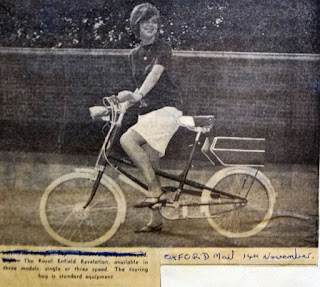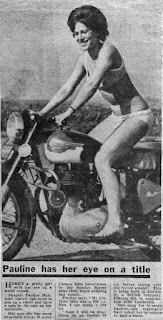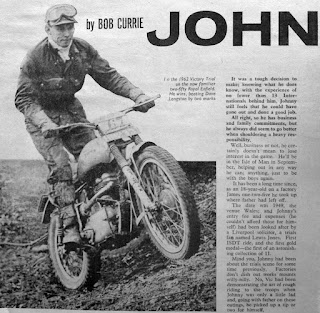The mid-1960s were critical for Royal Enfield in Britain. Times were changing. The whole British motorcycle industry was collapsing, although it wasn't yet apparent that this would be nearly total and nearly permanent.
Royal Enfield responded with surprising creativity, fielding the racy 250cc Continental GT, the world's first factory built café racer. The mighty 750cc Interceptor was re-positioned to conquer the growing and lucrative motorcycle market in the U.S. And a dedicated racing program was launched, headed by former world champion Geoff Duke.
Royal Enfield was determined to make headlines. And it did.
 |
| Royal Enfield Continental GT on cover of Scandinavian publication, January, 1965. |
And Royal Enfield kept track of those headlines, pasting them into scrapbooks now in the possession of the Royal Enfield Owners Club UK.
REOC archivist Bob Murdoch recently shared with me photocopies he made of the scrapbook pages. Seventeen volumes of them! They cover the years from 1913 to 1966. It's a stunning collection, both vast and rich.
Rich because the scrapbook pages say as much about the eras, attitudes and cares of their times as they do about the history of Royal Enfield itself.
There is nothing like a newspaper account of some long-forgotten motorcycle race to put you in the boots of the people on the ground. Reading, you are traveling in time.
So far I have only had time to peek into Vol. 17, for 1964-1966. In this volume alone there are 210 scrapbook pages to view.
They make it clear: Royal Enfield's hopes were high.
 |
| 1966 clipping shows a Continental GT café racer with raised handlebars meant to appeal to Americans. |
"I believe that 1965 will see a considerable expansion in our exports of both cycles and motor cycles," wrote Royal Enfield managing director L.H. Davenport in the March, 1965 edition of Motor Cycle & Cycle Export Trader.
He explained his enthusiasm, noting that Royal Enfield executives were visiting distributors in foreign markets, to find out what was wanted by customers there.
"An example of a special specification for a special purpose is the 'Wallaby' model -- a rugged high-ground clearance version of our 250cc model, made for Australian sheep farmers," he wrote.
And, as if capturing the business of Australian sheep farmers might alone not be enough to guarantee the future, the same issue carried a photo of the new Royal Enfield Revelation bicycle. It was an adult-sized bicycle with child-sized 20-inch wheels, making it capable of being stored in small spaces.
 |
| Royal Enfield creativity on two (bicycle) wheels, 1966. |
Royal Enfield was still making bicycles!
There was much else to celebrate.
The Continental GT had proved its worth in an epic one-day run from the top of Britain to the bottom, at Land's End.
"Was there ever a super-sports job so utterly arresting in its decor, so obviously 'what the lads want' as the Continental GT?" one writer asked, in a May, 1965 clipping. "Five speed gear box, glass fibre fuel tank in bright scarlet, swept-back exhaust -- the lot!"
 |
| Continental GT ran from tip-to-toe of Britain in one day. |
But in September, 1965 came an ominous short article entitled "Enfields Have a Trim."
The model line-up would be slashed, "to concentrate production on those machines, which are most in demand, and thus cut out the waiting which has occurred between the customer placing an order and deliveries."
The Continental GT was the best seller, "and many more will be produced next year," the article promised.
But only two other 250s, plus the 750cc Interceptor, and the two-stroke Turbo Twin would join them. The once mainstay 350cc Bullet was not coming back. (Luckily, production of an earlier Bullet model continued to present times, in India.)
 |
| Tony Wilson-Jones, left, with Phil Irving, key designers of British motorcycles. |
This scrapbook's widely varied subject matter includes a letter to the editor from Royal Enfield chief engineer Tony Wilson-Jones asking a tough question:
"How much extra do you think buyers would be prepared to pay for stainless tanks, handlebars, control levers, lamp rims, mudguards, exhaust pipes and silencers, wheel rims and spokes?"
All these shiny features were in demand by sales managers who, at the same time, complained to Royal Enfield that prices were already too high.
"I agree wholeheartedly about the virtues of stainless steel but, unfortunately, it does cost more and the machine won't look any better in the showroom," Wilson-Jones wrote. Meanwhile, buyers of Royal Enfield Interceptors reported finding, sadly, that fasteners on their bikes were "neither painted nor plated."
 |
| Air-cooled rider. |
In October, 1965, the scrap bookers were probably delighted with the Sunday Mirror for providing clippings of 24-year-old Pauline Maitland wearing a bikini while astride her Royal Enfield.
Loves to ride that way, the Mirror assures us.
In fact, she planned to compete so dressed in an upcoming speed competition in Italy, the paper said. (A follow-up article reveals that permission was denied.)
The scrap bookers did not hesitate to include criticism. A letter in Motor Cycle magazine of April, 1965, concluded that "Mr. Wilson-Jones' description of camber thrust and its effects is a load of convincing pseudo-scientific nonsense." (Wilson-Jones defended his science in a later edition.)
Royal Enfield suffered real losses in these years. Wilson-Jones, who had designed Royal Enfield motorcycles from 1925, would retire in 1963. He would be remembered for bringing the iconic "floating bush" crankshaft bearing to Royal Enfield, among so much more.
 |
| Johnny Britain and Royal Enfield rode to trials fame. |
Johnny Brittain had ridden works Royal Enfields in competition for 14 years. With 11 ISDT "golds" the nation's most experienced International trials rider, he would retire, Motor Cycling reported in July 1965.
Royal Enfield joint managing director Major Victor T. Mountford had been with Royal Enfield since joining as a sales trainee at age 16, in 1928. Motor Cycling magazine remembered that "The recent John-o-Groats-Land's End 'Continental GT' demonstration took place largely due to his enthusiasm, and he travelled to Land's End to welcome the finishing team member."
Mountford collapsed at his desk and died in November, 1964.
 |
| Major Mountford, a man Royal Enfield would miss. |
Ahead were corporate mergers that would bring Royal Enfield down from the exciting optimism of the 1960s. (It would at least go out on a high note, with the new Series 2 Interceptor its lone final product.)
The scrapbooks Bob sent seem to end before this point. But I look forward to diving into earlier volumes to learn more about Royal Enfield history.






















No comments:
Post a Comment